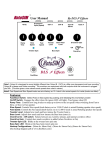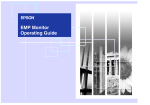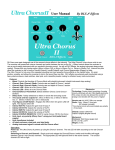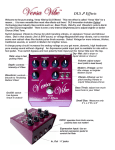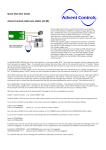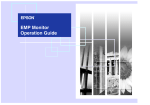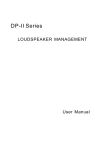Download User`s Manual - Master
Transcript
TM +9vdc Ramp Time User Manual Expression Input (Speed) Slow Speed Fast Speed By DLS Effects OUT A Tweeter Level OUT B Bass Rotor Level Input B Stereo Input A Overdrive Gain Off Tweeter Spin Bass Spin On Overdrive DLS Effects Fast/Slow On/Off Features: Fast/Slow Switch: Select Fast or Slow speed by pushing and releasing this momentary switch On/Off Switch: Engages the effect when On (green LED will light), True bypass when Off. Ramp Time: Controls how long it takes to ramp up or down to the set speed (when switching from Fast to Slow, or Slow to Fast speeds) Slow Speed: Controls the Slow speed (~12:00 O’clock position is actual Rotating speaker slow speed) Fast Speed: Controls the Fast speed (~12:00 O’clock position is actual Rotating speaker fast speed) Tweeter Level: Adjusts how much and how intense the Tweeter horn is. Bass Level: Adjusts how much and how intense the Bass horn (rotor) is. Overdrive On – Off switch: Selects between no overdrive (clean), and internal overdrive effect Overdrive Gain: Controls how much overdrive is added (when Overdrive is On) Tweeter Spin LED: Blinks at the tweeter horn spin rate Bass Spin LED: Blinks at the bass horn (rotor) spin rate Hookup Configurations: (Mono In: Mono Out), (Mono In: Stereo Out), (Stereo In: Stereo Out) (See hookup diagram pdf at www.dlseffects.com) Input A: Instrument input. Input B (Stereo): 2nd input for Stereo (When Input B is used, it is routed to OUT B. In this case the input B channel is separate from the Input A channel. The stereo image is generated from Input A and mixed with the isolated Input B.) Output A: Output (see hookup options below) Output B: Output (see hookup options below) Note about OUTA & OUTB: Output A is designed to sound slightly different to Output B. Output B is slightly deeper and thicker sounding. The musician can experiment with both outputs while the instrument is plugged into INA. This also gives a nicer stereo sound spread when used in stereo. Expression Input: An external expression pedal may be used to control the speed. Set the RotoSIM to Fast speed, then plug in the expression pedal. For dryer sound, set the RotoSIM to Slow speed, then plug the expression pedal in. Use a Roland EV-5 Expression pedal or equivalent. Internal Adjustments: Blend, InputA, InputB, OUTA, OUTB, Bass Lag (see below) ***Warning*** Static can destroy electronic parts. Discharge yourself by touching a metal surface such as a water pipe before opening the RotoSIM. Bass Lag: CCW makes bass rotate much slower than the tweeter InputB pot CW increases gain Do NOT adjust or you could damage your unit and void warranty InputA pot CW increases gain Blend: CW adds more effect , CCW adds more straight signal OUTA pot CW increases volume Effect response: CW more swirl sound, CCW the rotors are more pronounced and more throbbing OUTB pot CW increases volume Power “+9vdc”: Input for 9 to 13.8vdc, 90ma minimum, 2.1mm jack, polarity does not matter. (DC adapter included) Electronics: Technology: Hi Quality Analog (HQA) electronics and 16bit digital electronics Sample rate: 44.1KHZ, 256x over sample Mechanical: Enclosure: Solid heavy gauge steel, 5”W x 4.9”D x 2.4”H, Powder coat painted for durability! Controls: Steel switches, pots, and ¼” jacks Weight: 2½ lbs. Specifications subject to change without notice. All rights reserved, DLS Effects, Inc DLS Effects www.dlseffects.com © 1/05


